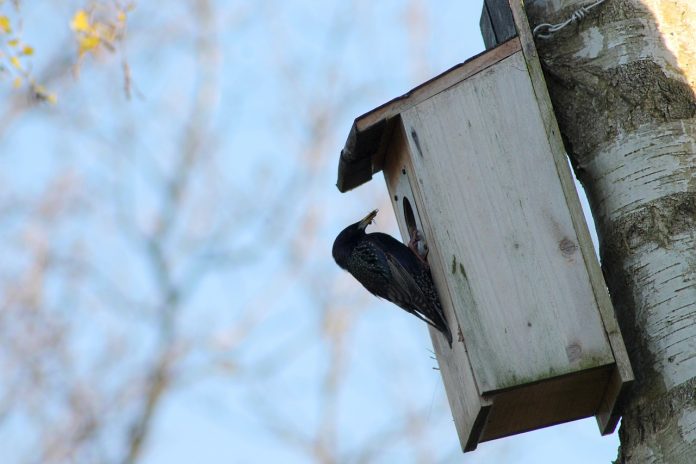In about six weeks, cavity-nesting birds such as chickadees and bluebirds will begin collecting nesting material to build their nests.
So it’s time to build or buy some nest boxes so the birds have time to accept the boxes as part of their habitat. To make a difference for cavity-nesters in your backyard, build (or buy) a few nest boxes, and get them up by mid-March.
In return, you’ll get to see these birds establish and defend territories, build nests and raise broods.
And if you’re lucky, you may see things that few others ever do.
For example, I’ve often seen aggressive house wrens steal nest sites from chickadees and bluebirds. And, back in 1983 while working in Oklahoma, I observed a situation I haven’t seen since.
Birdhouse war
A pair of bluebirds had built a grassy nest in a box in late March. Before any eggs were laid, I found a pile of sticks covering the bluebird nest. A Bewick’s wren had built its nest on top of the bluebird nest.
A few days later a pile of fresh green moss, courtesy of Carolina chickadees, covered the wren nest.
Finally, about 10 days after the real estate wars began, the bluebirds returned and built a new nest of pine needles on top of the first three nests. After raising four nestlings, all four chicks fledged.
The supply of dead trees and natural cavities limits the number of cavity-nesters that inhabit any area. Providing nest boxes is a simple solution to alleviate a nest site shortage.
But only cavity-nesting species have the strong feet and fearless disposition required to explore deep, dark nooks and crannies. Birds that use nest boxes vary with habitat.
Eastern bluebirds are limited to open country with a few scattered trees. Hayfields, pastures, cemeteries, and golf courses are ideal bluebird habitat, and if there’s a pond or wetland nearby, tree swallows may compete for cavities in these areas.
Chickadees, titmice, and wrens use nest boxes in more wooded settings. A simple 4-inch by 4-inch by 10-inch box with an inch-and-a-half hole is all bluebirds and these other small cavity-nesters require.
Build a bigger box (8 inches by 8 inches by 18-inches high with a 3-inch hole), and you might get an eastern screech-owl. Any untreated lumber will do. Use stock that’s three-quarters to one inch thick to insulate nests from spring chills and summer heat.
The actual design and appearance of the box are unimportant to cavity-nesters. They simply require a secure site that protects the nest from foul weather and predators.
Building tips
Here are a few more suggestions to keep in mind.
- Assemble with rust-proof screws to increase the life of the box.
- It’s not necessary to paint or stain nest boxes, but use light colored earth tones if you do. Do not paint the inside of the box. Put a shingle on the roof; it receives the greatest exposure and weathers faster than the sides.
- Extend the roof at least five inches over the front of the box to protect the hole from wind-blown rain and marauding paws. Drill four quarter-inch drain holes in the floor so the box drains well if it does get wet.
- Place the top of the entrance hole an inch below the roof. And protect the nest box from climbing predators with a metal predator baffle. This will prevent the nest box from becoming a predator feeder.
- Never put a perch on the outside of a box. Cavity-nesters have strong feet and easily cling to vertical wooden surfaces. A perch only invites house sparrows to use and defend the box.
- Be sure the box can be opened from the front or side for easy cleaning. A box that can’t be opened and cleaned is worthless after one nest.
- Finally, boxes should be in place by mid-March. Hang boxes so they will be shaded during hot summer afternoons, and orient the hole to avoid prevailing winds and driving rain.
Building a few nest boxes is a great way for parents, grandparents, and children to work together while learning the highs and lows of birds and nature.













